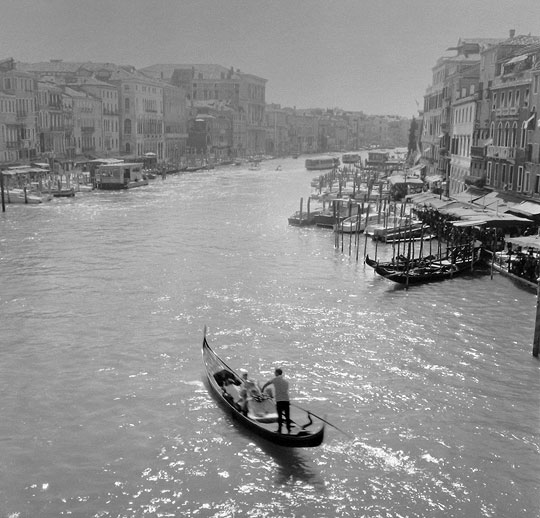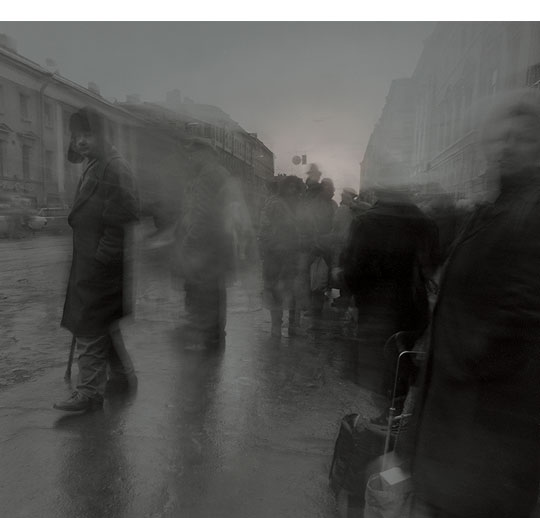














(via: http://www.alexeytitarenko.com/port_timestanding.html)

Venecia ha sido pintada, fotografiada, y escrita con tanta frecuencia que incluso las personas que nunca han estado allí se sienten familiarizados con ella. “Sin título (Columnas), 2006” es por lo tanto inmediatamente reconocible como una imagen tomada de la Plaza San Marcos mirando hacia el Gran Canal, con la alta columna de la izquierda apoyando una estatua del león que es el emblema de San Marcos, y el de la derecha, una estatua de San Teodoro. Es un día nublado con el sol envuelto en neblina, las personas que se congregan cerca del canal llevan paraguas, y las palomas en el primer plano está vadeando en charcos poco profundos. Pero la imagen tiene una sensación de indeterminación acerca de ella, cuándo, por ejemplo, fue tomada? El estilo de Titarenko tiene elementos que se asemejan a fotografías pictorialistas de finales del siglo 19 y principios del siglo 20.
Los componentes que Titarenko utiliza para lograr su estilo personal comienza con la elección de una cámara de formato medio, Hasselblad, y película Ilford de grano fino, que captura los detalles y gradaciones sutiles de la luz que son importantes en sus impresiones terminadas. Todos los fotógrafos componen sus imágenes y fijan sus exposiciones, pero las suyas se distinguen por su equilibrio formal y velocidades de obturación muy lentas, y las largas exposiciones afectan la rendición tonal y, más importante, los objetos presentes en movimiento, incluyendo personas, como borrosas. En “Columnas”, son los paraguas borrosos y las palomas los que nos dan un sentido de enfoque sin prisa del fotógrafo. Pero gran parte de la sensación de esta impresión se logró en el cuarto oscuro.
Titarenko expone su papel a un destello de luz antes de encender la ampliadora para iniciar el proceso de impresión. Utiliza un cóctel de sustancias químicas de su propia invención. Se sacude en rastros débiles de sepia para conseguir delicadas sugerencias de tono y aplicaciones muy selectivas de lejía para crear resaltados acentuales. Como resultado, “Columnas” tiene una sensación de gran profundidad, algo así como un daguerrotipo, y los grises de lujo que insinuan la antigüedad de la ciudad. La cámara apunta directamente hacia el sol brumoso que está centrado entre las dos columnas, y el fotógrafo a través de su técnica de cuarto oscuro ha traído el sol tenue de nacarado reflejo en los charcos de primer plano. El ambiente romántico es aún mayor por el viñeteado, que tiene las fronteras de la impresión fundido a negro. La oscuridad que invade los bordes de la imagen pone de relieve la precariedad de las condiciones meteorológicas, la multitud se acurrucó, la ciudad, y posiblemente algo mayor.
Las 19 fotografías de “Venecia” son fáciles de identificar como la obra de Alexey Titarenko a causa de su estilo único, pero en diferentes imágenes utiliza diferentes elementos de su estilo para lograr efectos diferentes. En “Sin título (San Marco / Kissing Couple), 2003”, la Basílica de San Marcos y el Campanile están en el fondo, y los edificios porticados aparecen en cualquier lado. La impresión ha sido blanqueada, lo que da al sitio conocido una cualidad atemporal, de ensueño. La velocidad de obturación lenta hace borrosos la mayor parte de los turistas y las palomas, por lo que se han convertido en espectros fantasmales de todos los turistas que nunca miran con asombro a su alrededor. Pero en el centro de la plaza, un hombre de negro y una mujer vestida de blanco se unen en un abrazo, y dado que permanecen, su imagen queda fuerte a pesar de la velocidad de obturación lenta; el amor permanece.
//
Venice has been painted, photographed, and written about so often that even people who have never been there feel familiar with it. “Untitled (Columns), 2006” is therefore immediately recognizable as a picture taken from the Plaza San Marco looking toward the Grand Canal, with the tall column on the left supporting a statue of the lion that is the emblem of St. Mark, and the one on the right a statue of St. Theodore. It is an overcast day with the sun shrouded in haze, the people crowded near the canal are carrying umbrellas, and the pigeons in the foreground are wading in shallow puddles. But the image has a feel of indeterminacy about it; when, for instance, was it taken? Titarenko’s style has elements that resemble pictorialist photographs from the late 19th and early 20th centuries.
The components Titarenko uses to achieve his personal style begin with his choice of a medium-format camera, a Hasselblad, and fine-grained Ilford film, which capture the details and subtle gradations of light that are important in his finished prints. All photographers compose their images and set their exposures, but his are distinguished by their formal balance and very slow shutter speeds; the long exposures affect the tonal rendition and, more important, present moving objects, including people, as blurred. In “Columns,” it is the blurred umbrellas and pigeons that give us a sense of the photographer’s unhurried approach. But much of the feel of this print was achieved in the darkroom.
Titarenko exposes his paper to a flash of light before turning on the enlarger to begin the printing process. He uses a cocktail of chemicals of his own devising. He brushes on faint traces of sepia to achieve delicate suggestions of tone, and very selective applications of bleach to create accentual highlights. As a result, “Columns” has a feeling of great depth, something like a daguerreotype, and luxurious grays that intimate the antiquity of the city. The camera is pointed directly at the hazy sun that is centered between the two columns, and the photographer through his darkroom technique has brought out the dim sun’s pearly reflection in the foreground puddles. The romantic atmosphere is further enhanced by vignetting, having the borders of the print fade to black. The encroaching darkness at the edges of the image emphasizes the precariousness of the weather, the huddled crowd, the city, and possibly something larger.
The 19 pictures in “Venice” are all easily identified as Alexey Titarenko’s work because of his unique style, but in different pictures he uses different elements of his style to achieve different effects. In “Untitled (San Marco/Couple Kissing)” (2003), St. Mark’s Basilica and the Campanile are in the background, and the arcaded buildings appear on either side. The print has been blanched, which gives the familiar site a timeless, dreamy quality. The slow shutter speed blurred most of the tourists and pigeons, so that they have become ghostlike wraiths of all the tourists ever to stare in wonder at their surroundings. But in the middle of the square, a man in black and a woman in white are fixed in an embrace, and because they are still, their image is sharp in spite of the slow shutter speed; love abides.
(via: http://www.nysun.com/arts/)





















Alexey Titarenko ha fotografiado San Petersburgo desde que tenía 8 años de edad. De hecho, dice, que ha dedicado toda su vida a la ciudad. Titarenko ve sus fotografías como un reflejo de la historia de su ciudad, y Rusia, en los últimos 20 años.
“A través del prisma de mi ciudad natal, trato de mostrar los eventos que ocurrieron no sólo aquí, sino en todo el país – los cambios, las catástrofes y las tragedias humanas que han azotado a esta ciudad y la gente de esta tierra”.
En la década de 1990, Titarenko estaba trabajando en una serie de fotografías sobre el totalitarismo, centradas en los signos y las estatuas que se derrumbaron a su alrededor como fracaso del comunismo soviético. La pobreza fue propagada por el racionamiento introducido.
“La comida fue racionada. Para obtener comida a cambio de los cupones de racionamiento, la gente corría de un almacén a otro, con aire desesperado, y los ojos llenos de tristeza. Puse mi cámara a la entrada del metro para tomar fotografías.”
“La actividad en torno a la estación, que se encuentra en un distrito comercial, se superpone con las sensaciones que sentí cuando escuché ciertas composiciones musicales, Sinfonía 13 de Shostakovich, en particular, el movimiento titulado ‘En la tienda’.”
“La masa de gente que fluye alrededor de la estación de metro formaban una especie de marea humana, dándome una sensación de irrealidad, de fantasmagorías, estas personas eran como sombras, uno podría encontrarlas en el inframundo. Me decidí a expresar ese sentimiento en mi trabajo, para transmitir mis expresiones personales. Tenía que encontrar una metáfora visual que permitiera al espectador compartir mis sentimientos tan agudamente como sea posible. Eso es lo que me impulsó a probar un proceso de larga exposición.”
Las imágenes de Titarenko fueron inquietantes, preocupantes, como fantasmas malévolos llenando la imagen. Llamó a la serie “Ciudad de Sombras”.
//
Alexey Titarenko has photographed Saint Petersburg since he was 8-years-old. In fact, he says, he has dedicated his whole life to the city. Titarenko sees his photographs as reflecting the history of his city, and Russia, over the past 20 years.
“Through the prism of my native city, I attempt to show events that occurred not only here, but throughout the country – the changes, the catastrophies, and the human tragedies, which have swept this city and the people of this land.”
In the 1990s, Titarenko was working on a series of photographs about totalitarianism, centered on the signs and statues that were crumbling around him as Soviet communism failed. Poverty spread as rationing was introduced.
“Food was rationed. To obtain food in exchange for the ration tickets, people would run from one store to another, with a desperate air, and their eyes full of sorrow. I’d place my camera at the subway entrance and take photographs.”
“The activity around the station, which was located in a shopping district, overlapped with the sensations I felt when I listened to certain musical compositions, Shostakovich’s 13th Symphony in particular, the movement entitled ‘At the Shop’.”
“The mass of people flowing around the subway station formed a sort of human tide, giving me a sensation of unrealness, of phantasmagoria, These people were like shadows, one would meet in the Underworld. I decided to express that feeling in my work, to convey my personal expressions. I had to find a visual metaphor that would enable the viewer to share my feelings as acutely as possible. That is what prompted me to try a long exposure process.”
Titarenko’s pictures were haunting, disturbing, like malevolent ghosts crowding the frame. He called the series “City of Shadows”.
(via: http://dangerousminds.net/)








